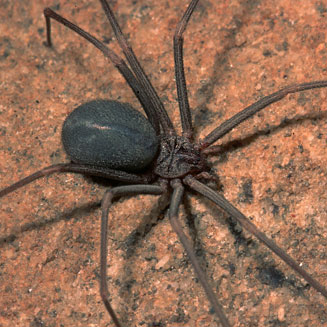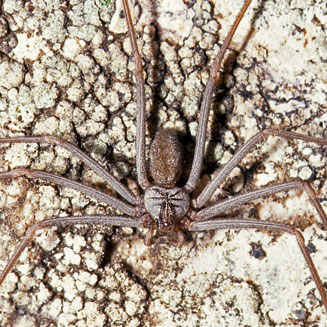|
Violin spider bites
back to Spider bites;
back to Loxosceles
Loxosceles, the Violin spider with
Sicarius, Six-eyed sand spiders, constitute
the tropical to subtropical family Sicariidae. The spiders in this family have a
virulent cytotoxic venom and one death did occur in South America from a bite by
Loxosceles laeta a species not found in Africa. The venom is stronger than that
of Sac spiders.
 |
 |
|
Loxosceles
sp. (Violin spider). [image N. Larsen ©] |
The name Loxosceles relates to the slanted fashion in which the legs are held
with various colloquial names in use; Violin spiders and Fiddle backs relating
to the violin shape marking on the carapace of some species; also called Recluse and Brown
spiders. The three latter names are in use in America.
Violin spiders are those spiders most surrounded by myths and hoax emails. In
2003 an email made its debut in America about these spiders invading highly
populated areas causing mass hysteria. An image of the American Brown recluse
spider, Loxosceles reclusa, was included with a disturbing sequence of images of
a hand with severely ulcerated thumb which is not proven to be a spider bite at
all. This email did a world tour including a few circuits of South Africa
warning of invasions of the Western Cape and Gauteng and pending danger and
possible death. Unfortunately this email was inadvertently also forwarded by
ignorant office workers from environmental, health, National Parks and
conservation bodies as well as the local press.
Rick Vetter, University of California, has extensively researched all cases in
the United States and has continued an endless crusade refuting the myth about
Loxosceles reclusa bites. In the highly populated coastal California 700 cases
of recluse spider bites were diagnosed annually yet only 15 specimens have been
collected in the last 40 years. Truly cases of translocations. He also reports
in the mid west of America where the synanthropic Loxosceles reclusa is very
common, with students collecting 60 spiders, even collecting them by hand, without
a single bite. In an old 1850s house 2055 recluse spiders were collected over a
period of 6 months and none of the inhabitants were ever bitten. Subsequently
the mother, after residing in the house for over 8 years was bitten on the
finger while reaching into the basket of clothes ready for ironing without any
serious envenomation. In southern Africa there are more than 10 species of
Loxosceles, but they are fairly uncommon except for the Witwatersrand, Gauteng,
where the synanthropic Loxosceles parrami occurs, although bites are
rare.
Loxoscelism is the term used for envenomation by these spiders. It is important
to note that, as with the sac spiders, necrotic lesions by Violin
spiders are self limiting and heal spontaneously without medical intervention
when kept clean to prevent secondary infection.
Violin spider bites normally occur at night and are not felt as the tiny fangs
only just penetrate the skin. No visible bite mark is present. Slight swelling
and redness (oedema and erythema) is evident after 2 hours, the central area may
have a purple discolouration and can spread to 20mm in the next 6-8 hours at
which stage it is painful. A blister usually develops at 2-3 days, collapsing at
10 days leaving a necrotic crater-like lesion 20-100mm in diameter. The lesion
is now susceptible to infection but spontaneously starts healing a process that
can take a few months and may require cosmetic surgery. The milk tart appearance
normally result in doctors operating to remove the necrosis but this is actually
the lesion healing as can be seen in the photographic images.
Treatment and the differential diagnosis are as for Sac spider bites.
Text by Norman Larsen © |
